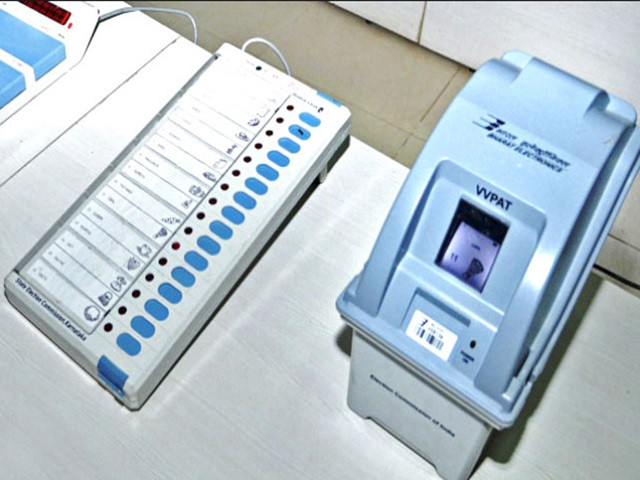Apart from voicing its confidence in the EVMs, the Election Commission has not spelt out enough details of how these machines work, operate and run

You might find it unusual indeed that the Congress (and INDIA) have brought the EVMs straight back into the news. The party which was largely involved in implementing India's electronic voting machines, is today raising doubts about whether these can be hacked.
On the other hand, the EVMs are being vociferously defended by the BJP. Let's not forget that it was this very party which was once opposed to these supposed wonders of modern technology. Thanks to the Internet, it is easy to recall that in February 2010, the BJP's election analyst GVL Narasimha Rao wrote a book on the risks of the EVMs. It was released by then the BJP president Nitin Gadkari.
The BJP's senior leader, LK Advani, had then also asked the Election Commission to "remove doubts" about the fairness of the EVMs. He had also sought a law "modelled on the measures taken by 32 of the 50 US states mandating that EVMs be used only if there is a paper backup for every vote cast electronically" (Hindustan Times).
Ironies apart, two questions remain. Can the EVMs be manipulated in any way? And, how much faith do people have in electronic voting? One thing is clear. The promise of quicker election results has hardly come true, despite having implemented EVMs at all levels.
Is that true? By 2019, Swaminathan S Anklesaria Aiyar was asking in the Times of India: "In Digital India, why do elections stretch for weeks?" He pointed out that most electoral democracies have single-day polls, and, in the US, counting of votes on the east coast starts before polling ends on the west coast.
Aiyar noted too that, by comparison the 2004 general elections took 21 days in India, 28 days in 2009, and no less than 37 days spread over nine phases in 2014. Even single states like Bihar (24 days in 2015) and Uttar Pradesh (26 days, over seven rounds in 2017) took a long time. Our 2024 elections will take place over 44 days. Some record that. In 1980, voting took just four days.
Recently, a STEM (Science, Technology, Environment and Maths) group in Goa was discussing this issue online. Initially, there was some reluctance to discuss the issue.
Strangely enough, there have been debates right from the 1980s over the efficacy of the EVMs, and how safe and secure (read: hacking free) these really were. While we will probably never know whether these machines have been played around with or not, we need to be very certain that they cannot be interfered with, directly or otherwise.
EVMs were first proposed in India in 1977. Paravur in Kerala was the first constituency to use the EVMs in a 1982 bye-election. The Internet reminds us that CPI won the seat with a majority of 123 votes. When the Congress challenged the same, on technical grounds (electoral laws didn't permit the use of EVMs then), a repoll was ordered, and the Congress defeated the CPI. But, of course, this was a repoll.
Two insightful points of view come up sharply in the EVMs debate. The second is a fairly-long YouTube video titled 'Are EVMs and VVPATs vulnerable?' by the former IAS offer Kannan Gopinathan. Gopinathan was himself an electoral officer at one stage, and as he admits, a staunch defender of EVMs for quite some time. Then, this tech skilled former official had a change of heart, and his is one of the very convincing arguments over EVMs. He looks at the issue dispassionately and tackles it with analytical honesty.
Someone argued that, if anyone has the evidence, they should present it before the courts. Unfortunately, there are no EVMs which are out there in the public, that can be tested and worked on. Apart from voicing its unhesitating confidence in the EVMs, the Election Commission has not spelt out enough details of how these machines work, operate and run.
When the Election Commission allowed for a "hacking" test on these machines, in June 2017, it did so under very limited and restricted conditions. Only political parties were allowed to take part. As was pointed out, even if a political party had this knowledge with them, would they leak it out into the open?
The IAS official Gopinathan, mentioned above, systematically goes about pointing out how the claims made about the EVM's standalone and unconnected nature are not quite true. He points to how data and lists of candidates can be fed into the EVMs. His argument is lucid and convincing. He doesn't jump to the conclusion that the EVMs were hacked, but merely raises the possibility that they could be. Every such doubt needs to be laid to rest.
The 2010 paper is more blunt in its assessment. It says: "Despite elaborate safeguards, India’s EVMs are vulnerable to serious attacks. Dishonest insiders or other criminals with physical access to the machines can insert malicious hardware that can steal votes for the lifetime of the machines. Attackers with physical access between voting and counting can arbitrarily change vote totals and can learn which candidate each voter selected."
Supporters of openness and transparency have long pointed out that the source code which runs these machines should be made publicly known, so that these can be tested for vulnerabilities.
Ironically enough, even the attempt to insert a VVPAT into the EVMs to allow for a paper trail has only complicated the issue. Now, another layer has come in between the voter and the vote registered. Besides, the paper trail kept by the VVPATs (voter-verified paper audit trail) is not separately counted, except in a very few machines, to cross check that all is secure and working fine.
At the end of the day, the voter needs to be reassured that votes reach the person he or she intended it for.